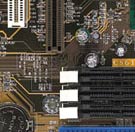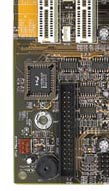The Layout
/ PCB

 The
CS61 features somewhat of a standard design. As with all 815xx Solutions the
board’s features three well-positioned DIMM slots. The DIMMs are interfering
with the video adapter (AGP) when installed. This little “bug” is
present on several of today's mainboards and generally results in unpleasant
experiences due the fact that when upgrading your RAM will require to remove
the video adapter.
The
CS61 features somewhat of a standard design. As with all 815xx Solutions the
board’s features three well-positioned DIMM slots. The DIMMs are interfering
with the video adapter (AGP) when installed. This little “bug” is
present on several of today's mainboards and generally results in unpleasant
experiences due the fact that when upgrading your RAM will require to remove
the video adapter.
 Another
little design flaw on the CS61 is its FDD connector placement. DFI opted and
placed it vertically at the very bottom of the board along with the PCI ports.
I would have preferred to see it close to the two HDD connectors; this would
have resulted in a cleaner design.
Another
little design flaw on the CS61 is its FDD connector placement. DFI opted and
placed it vertically at the very bottom of the board along with the PCI ports.
I would have preferred to see it close to the two HDD connectors; this would
have resulted in a cleaner design.
The CS61features two 40-pin
IDE connectors marked as IDE1 and IDE2. Each connector supports up to two
IDE devices. Thanks to the AC97 codec on the ICH2 controller, onboard sound
is present. This particular codec is very similar to the Sound-Blaster 16
card and should satisfy most of the office users. However, if you are playing
a lot of games and/or use a multi-channel sound system, you would be better
off with a normal high-end audio card such as the SBLIVE. The implanted audio
solution features two different internal audio connectors (CD-in/TAD) on the
PCB. These connectors allow you to receive stereo audio input from sound sources
such as CD-ROM drives and TV Tuners.
 The
power supply connector is located on the left of the 815xx chip, this unfortunately
might be another design flaw on the CS61 because the power cables might run
over the memory and CPU which would potentially block airflow.
The
power supply connector is located on the left of the 815xx chip, this unfortunately
might be another design flaw on the CS61 because the power cables might run
over the memory and CPU which would potentially block airflow.
The expansion of the CS61
can be considered maximum. DFI opted for 6 PCI slots and an optional CNR slot
for people looking to take advantage of the integrated network controller
in the 82810BA ICH2 or other CNR based devices such as a V90 phone modem.
The j18/19 connector on the PCB allows to connect the optional third or fourth
USB ports supported by the 815xx platform, this will have to be bought extra,
as DFI did not bundle it. The CS61-EC is also equipped with an IrDA connector
for wireless connectivity between your PC and peripheral devices.
The CS61-EC offers different
front side bus settings in order to overclock the processor. The changes can
be done via BIOS. DFI placed two jumpers (JP2/JP3) on the board that lets
you choose the main FSB for your processor. For example, if you run on a Pentium
III EB (133MHz) Processor the choices for overclocking will be 133Mhz and
higher, in little MHz choice. For a standard E Processor (100MHz) the choices
will start from 100MHz and reach 129MHz in little MHz choices.